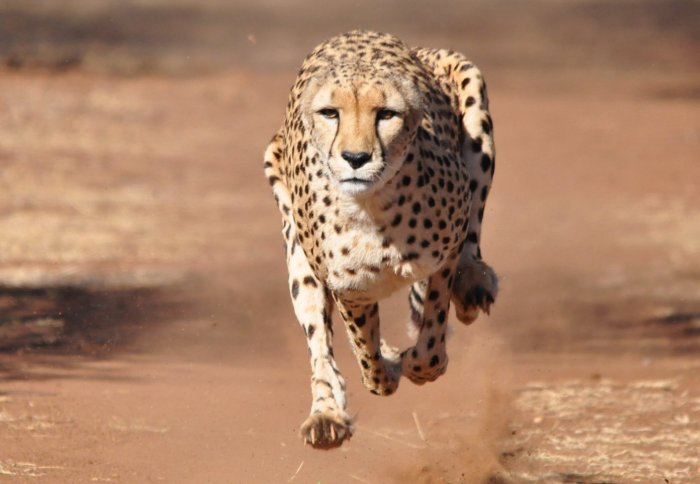

Scientists have discovered why the largest animals are not the fastest, and have used a model to predict the speed of extinct animals like dinosaurs.
As animals get larger, they get faster – but only up to a point. A rabbit could beat a mouse in a race, just as a mouse could beat a beetle. But nothing beats a cheetah on land, even though there are plenty of larger animals like elephants.
The theory is simple, yet extremely powerful and allows us to make predictions across the animal realm of how optimised or not species are for speed.
– Professor Walter Jetz
For the first time, scientists have been able to model the relationship between an animal’s size and its maximum speed and why animal speeds only increases up to a certain body size. Using the model they can accurately predict the top speed of any animal from just its weight and the medium it moves in: land, air or water.
The simple model can even be used to predict the speed of extinct animals like dinosaurs, with an accuracy matching that of complex biophysical models.
The research team, under the direction of the German Centre for Integrative Biodiversity Research (iDiv) and the Friedrich-Schiller-University Jena and including a researcher from Imperial College London, published their findings today in Nature Ecology and Evolution.
The model calculates the maximum speed that an animal can reach with almost 90 per cent accuracy. Lead author of the study, Myriam Hirt of the iDiv research centre and the University of Jena said: “The best feature of our model is that it is universally applicable. It can be performed for all body sizes of animals, from mites to blue whales, with all means of locomotion, from running and swimming to flying, and can be applied in all habitats.”

The model is based on two principles that reveal why animal speed increases with size up to a certain point, after which it decreases again.
The first is that animals reach their maximum speeds during comparatively short sprints, and not while running over long distances. When running over longer distances the body constantly resupplies the muscles with energy (aerobic metabolism). However when the body is sprinting it uses energy that is stored in the muscles themselves but which is exhausted relatively quickly (anaerobic metabolism).
This would imply that as larger animals have more muscle, they can sprint faster. However, it takes more initial energy to get a larger mass moving in the first place - so a five-tonne African elephant simply cannot start moving as quickly as a 2.5-gramme Etruscan shrew.
By the time large animals such as elephants get up to full speed while sprinting, their rapidly depleting energy reserves soon run out, meaning they run more slowly.

Professor Walter Jetz, from the Department of Life Sciences at Imperial and the Department of Ecology and Evolutionary Biology at Yale University, said: “We find that there is a ‘sweet spot’ in size for a given body and movement type - exactly where cheetahs, peregrines or marlins land - where the energy available for acceleration allows them to get closest to their maximum theoretically possible speed.
“The theory is simple, yet extremely powerful and allows us to make predictions across the animal realm of how optimised or not species are for speed.”
To test whether the model could work for extinct species, the team compared the model’s predictions of dinosaur speeds to those obtained through biomechanical simulations.
Predictions based on the model for Triceratops, Tyrannosaurus, Brachiosaurus and others matched those from complex simulations. They also confirmed a pretty slow speed for Tyrannosaurus, of only 27 km/h (17 mph). Hirt said: “This means that in future, our model will enable us to estimate, in a very simple way, how fast other extinct animals were able to run.”
-
‘A general scaling law reveals why the largest animals are not the fastest’ by Myriam R. Hirt, Walter Jetz, Björn C. Rall and Ulrich Brose is published in Nature Ecology and Evolution.
Article text (excluding photos or graphics) available under an Attribution-NonCommercial-ShareAlike Creative Commons license.
Photos and graphics subject to third party copyright used with permission or © Imperial College London.
Reporter
Hayley Dunning
Communications Division

Contact details
Tel: +44 (0)20 7594 2412
Email: h.dunning@imperial.ac.uk
Show all stories by this author
Leave a comment
Your comment may be published, displaying your name as you provide it, unless you request otherwise. Your contact details will never be published.




Comments
Comments are loading...